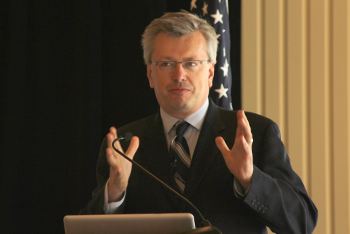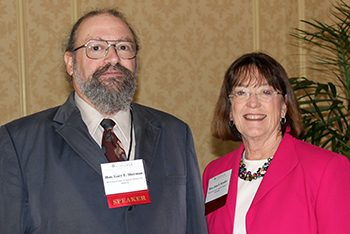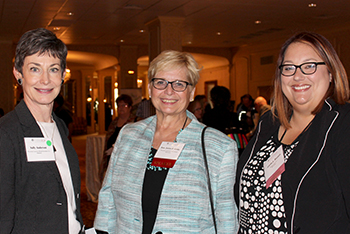<iframe src="//www.youtube.com/embed/XGbR5iH48wg?rel=0&autohide=1" width="325" height="250" frameborder="0" allowfullscreen></iframe>
Legal “futurist” Jordan Furlong highlights the vast, untapped legal market that exists, and discusses how it poses unique opportunities and challenges for lawyers.
May 23, 2014 – Did you know lawyers compete to serve just 15 percent of the total market for legal services? Do you wonder how lawyers can profitably serve the other 85 percent? Would you ever conceive of lawyers as “incidental” to legal services?
Those attending the State Bar of Wisconsin PINNACLE’s Litigation, Dispute Resolution & Appellate Practice Institute, May 22-23, in Milwaukee pondered these questions, asked and analyzed by a speaker who wants lawyers to “become essential again.”
The event featured a number of high-profile speakers and panelists, including “futurist” Jordan Furlong, who discussed the forces that are changing the legal market. Furlong also provided numerous strategies to help lawyers and law firms adapt to change.
Furlong, a lawyer, industry analyst, and consultant based in Ottawa, Canada, discussed what lawyers can do to make themselves essential, not incidental, in a legal market with advancing technology, new regulation, and increased competition.
Tapping the Underwater Iceberg
For instance, Furlong says lawyers must reevaluate the marketplace for legal services. Currently, lawyers and firms are competing to serve a mere 15 percent of the entire legal market, defined as the market of people and businesses with justiciable issues.
In a lawyer’s eyes, Furlong says, the legal market generally consists of those clients that have the money to pay for their legal services. There is no shortage of lawyers and law firms that are able and willing to serve these types of clients, Furlong says.

Jordan Furlong, a lawyer, consultant, and legal industry analyst speaks about the “new legal world” and what lawyers can do to compete with new competitors, tap untapped legal markets, and remain essential to clients.

District IV Appeals Court Judge Gary Sherman and District I Appeals Court Judge Joan Kessler discuss what appellate practice approaches are persuasive – and which are not – on a panel.

(From left) Sally Anderson of Wisconsin Lawyers Mutual Insurance Company, former Supreme Court Justice Janine Geske, and Milwaukee lawyer Amelia Bizzaro chat following a breakout session.
If lawyers view the legal market as every person or entity that has a justiciable issue, regardless of their ability to pay the lawyer’s going rate, the legal market becomes a vast market largely untouched by lawyers. In fact, it’s about 85 percent of the market.
“The analogy that I use frequently is that of an iceberg. Icebergs, of course, are 15 percent above water and 85 percent below water,” Furlong said. “When you look at the 15 percent above water: that is the legal marketplace that lawyers know very well.”
But failing to find ways to serve the 85 percent of potential clients that exist under water presents a missed opportunity for lawyers, and comes with a social cost, Furlong says.
“My message to lawyers is that we have never really served the entire legal market. There are many unmet legal needs and requirements that we simply have not noticed or we simply said, ‘there is not enough money in that for us,’” Furlong said.
“What I want to make clear is that all these new technologies, all these new providers, all these new developments, they are taking aim at this segment of the market and they are finding ways to serve them. The other point is that these providers may start under the water but they are going to start moving up towards the surface in a real hurry.”
Of course, the question lawyers will ask is: how do I serve clients that can’t pay the going rate? Furlong says the use of technology and other strategies can help lawyers profitably serve clients who traditionally could not afford their services.
Furlong says many law firms don’t understand the technology and other tools that exist to reduce the cost of doing business. For instance, if the fixed price is $500, and the cost to provide the service is $400, how do you reduce the cost to provide the service?
When firms understand costs, they are in a much better position to fix prices, or come up with pricing arrangements that fit the particular matter or client. Offering such predictability allows the firm to find more ways to serve more clients profitably.
Furlong presented a number of strategies to help lawyers tap the larger legal market, and to become essential in a legal environment filled with new competition. In addition, Furlong offered advice on what lawyers must do to prepare themselves for the future.
“I’m not sure what 2020 is going to look like, but I’m pretty sure it won’t look like 1995,” said Furlong, who gave a plenary talk before a more in-depth workshop for attendees.
Other Speakers and Panelists
There was no shortage of other speakers and panelists on topics in litigation, dispute resolution, and appellate practice. Numerous judges appeared to offer insight and tips. And numerous veteran attorneys spoke at breakout sessions on specific topics.
For instance, Court of Appeals Judges Lisa Neubauer (District II), Joan Kessler (District I), and Gary Sherman (District IV) gave appellate lawyers advice on writing more persuasive briefs, covering all aspects of the appellate brief.
“It is very important for the lawyers to decide from the beginning what arguments are really persuasive and have an opportunity to win,” Judge Kessler said.
“If you have other arguments that the client is insisting you make, note that they may diminish the effectiveness of the one or two arguments that are really important.”
Madison lawyer Marie Stanton, a litigator and mediator, was on a panel discussing how lawyers can better assist their clients in the mediation process.
“It starts at the beginning, picking the mediator,” Stanton said. “Some cases depend on relationship building for settlement. Others depend on numbers, or certain areas of expertise. So, we want people to take some time in picking the mediator.”
“And then we want the lawyer to spend some time in preparing the client for the mediation,” said Stanton, among other tips the panel provided for lawyers.
Former Supreme Court Justice Janine Geske and former Waukesha Circuit Court Judge Patrick Snyder joined Oshkosh attorney George Curtis Jr. as panelists discussing the cause and effect of the disappearing jury trial in America.
For an in-depth article on this subject, see the “The Disappearing Jury Trial: Implications for the Justice System and Lawyers,” published in WisBar InsideTrack.
Other speakers provided tools and tips on issues involving negotiations, experts witnesses, and electronically stored information, among other topics.
Watch a Recorded Session
Select sessions of the 2014 Litigation, Dispute Resolution & Appellate Practice Institute were recorded and will be available via webcast at a later date. Check the State Bar PINNACLE’s webcast calendar soon to confirm the viewing dates.
Attended the Institute but missed a session? All Institute attendees will be allowed to attend the first two webcast replays on June 17 & 24, 2014 for free.
